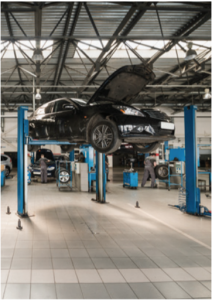A Missed Opportunity
The automotive industry is in a state of change with the advent of electric and autonomous vehicles and the ownership model moving toward mobility-as-a-service. The one constant in this changing market is the need to properly maintain vehicles no matter the propulsion system or ownership model. Maintaining vehicles with Original Equipment (OE) parts ensures proper fit and function.
Automakers have long had successful and robust Mechanical Wholesale and Collision Wholesale programs designed to sell parts. These programs, while robust, fail to capture a sizeable portion of part sales for older vehicles. One reason we explore in this paper is demand generation – how to create additional demand for an automaker’s existing parts programs.
Sales of cars and trucks have been robust since the end of the Great Recession in 2009. Service has also expanded due to vehicles being driven for longer periods of time. Consumers today are keenly aware of the need for preventive maintenance, repairs and scheduled servicing to extend the overall value of their vehicles. This has subsequently created rising demand for parts and services, resulting in new growth and revenue opportunities for many businesses such as independent auto repair shops, collision shops and OE-franchised dealerships.
Independent shops, which perform more than 70% of all post-warranty service and repairs, typically buy most of their parts from non-OE sources that often don’t offer OE-branded parts in their database. There is significant untapped opportunity for OEs and dealers to sell more of their parts to independent repairers, and this additional demand can be met with existing programs by partnering with a trusted data provider to code OE parts and make that enhanced information available to everyone involved in the parts-purchasing decision.
Independent shops, which perform more than 70% of all post-warranty service and repairs, typically buy most of their parts from non-OE sources that often don’t offer OE-branded parts in their database.
Data Shows Parts Opportunity Grows as Vehicles Age
Americans have been buying new and used vehicles at a record pace. These vehicles are lasting longer as a result of the great quality that goes into vehicle production. IHS said the number of vehicles on the road that are at least 25 years old represents 14 million, an increase from eight million in 2002. Furthermore, there are about 44 million vehicles that are 16 to 24 years old, a number that is up from 26 million in 2002.
These aging vehicles aren’t going away anytime soon. Edmunds analysts expect 2019 used vehicle sales to reach 41 million, their highest level since the recession. With sticker prices on new vehicles rising and incentives falling, older used vehicles could remain a very popular choice in the coming years.
All of this means the opportunity for post-warranty parts sales will continue to increase.
 The Original Equipment Parts Opportunity
The Original Equipment Parts Opportunity
Industry estimates show that the global automotive aftermarket industry is expected to reach $722.8 billion by 2020. However many dealers and OEs are missing out on a large opportunity since a majority of this is represented by non-OE parts utilized by independent auto repair shops. Sure, aftermarket parts can sometimes be less expensive, but today a majority of OE parts are not coded to be visible in the database many of these shops use to purchase parts. By making these parts available, coded to industry standards and visible in the databases where OE parts are noticeably absent, automakers will create more demand in both mechanical and collision wholesale markets.
Fixed operations account for one-half of dealership gross profits, while capturing only one-third of the available market. According to the NADA’s Annual Dealer Financial Profile research, fixed operations accounted for 49% of dealership gross profits in 2017, yet dealerships currently receive only 33% of all service visits in the U.S. according to a recent Cox Automotive Service Industry Study.
The OE opportunity is to capture more of this available market. Dealerships are turning to e-commerce and mail-order sales of parts to help boost their income from fixed operations. Many automakers support and encourage this strategy through incentives and co-op funds to help push the sale of their parts. Not only are the parts sales highly profitable, but the use of OE parts on vehicles ensures a positive brand experience.
Industry estimates show that the global automotive aftermarket industry is expected to reach $722.8 billion by 2020. However, many dealers and OEs are missing out on a large opportunity since a majority of this is represented by non-OE parts utilized by independent auto repair shops
Proper Coding Unleashes Demand
Identifying the correct part is more difficult in an aftermarket setting than in a dealership. With just a VIN, a dealership can identify the exact part needed for a repair. An independent repairer, however, needs to supply year-make-model, part type and various part type characteristics to be presented with a choice of parts. Only properly coded parts are presented to the decision-maker.
ACES (Aftermarket Catalog Enhanced Standard) is the North American industry standard for the management and exchange of automotive parts data. With ACES, suppliers can publish automotive data using standardized vehicle characteristics, parts classifications and qualifier statements, giving properly coded parts the advantage.
Most automakers have not made their parts data widely available and coded to ACES standards, missing out on the opportunity to have their parts available to the 160,000 U.S. automotive service and repair locations in need of quality parts for repairs. Making properly coded OE data more widely available will generate more demand for OE parts.
New Technologies Address Old Concerns
Automakers have historically been concerned that making their parts information widely available benefits only their competitors. With dramatic changes in technology influencing data use and delivery, limiting access to parts information today is counterproductive.
For example, the advent of e-commerce has taught customers to shop around for products. If data is not made available on all e-commerce platforms, the owner of the data will not even be in consideration.
Most automakers have not made their parts data widely available and coded to ACES standards, missing out on the opportunity to have their parts available to the 160,000 U.S. automotive service and repair locations in need of quality parts for repairs.
Automakers can only have confidence to make their data available with the right governance—who is allowed to distribute the data, where is it going and how is it used? Trusted data providers today have key relationships with tight contracts that control how companies can and can’t use the OEM data – similar to the way Apple controls how music is downloaded with royalties paid back to the artist, which in this case is the OEM.
For continued confidence in the control of their data, an automaker needs transparency into the use of that data. Today’s technology enables precise tracking of massive amounts of data, and this transparency can provide new insights into parts demand.
 The Impact of a Trusted Data Partner
The Impact of a Trusted Data Partner
Consider two examples: 1) A leading automaker recently engaged their trusted data partner to enhance their unique fluid part numbers and insert them at the point of estimating to ensure their part was visible. 2) Another leading automaker engaged their data partner to code their parts data to the standard for e-commerce used by the aftermarket, enabling them to publish their parts availability on all major e-commerce and mechanical estimating platforms to create demand where it didn’t exist before. Both automakers believe these initiatives resulted in significant market expansion and part sales.
Trusted data providers today can help automakers create and execute on a comprehensive data strategy, to best determine where the data goes, prioritize opportunities while casting a wide net, and ensuring that it will be protected.
Trusted data providers today can help automakers create and execute on a comprehensive data strategy, to best determine where the data goes, prioritize opportunities while casting a wide net, and ensuring that it will be protected. These data providers will provide broad market access through sophisticated, advanced tools and technologies built with leading market intelligence. Ultimately, they will help OEM data get delivered through a multitude of delivery technologies that include bulk distribution, web services, batch delivery, etc. They can help OEMs determine which data assets should be made available, including an inventory of data that’s currently not utilized or underutilized. Lastly, the right data partner can help determine use cases for maximum value and can add value to the data to allow downstream customers to append other data, and make it commercially available with industry standards, link parts, services and images.
In summary, the opportunity is large and growing, the risks of yesterday are addressed by new technology and trusted data partners. Automakers have the products to compete. Creative pricing and packaging and placement in the right channels will create demand for existing Mechanical and Collision Wholesale programs.
ABOUT MOTOR
MOTOR Information Systems is one of the world’s premier suppliers of automotive data and a trusted partner of leading Automakers, helping sell parts and service vehicles. Since 1903, MOTOR’s mission has been to provide customers with accurate, thorough and timely information to help run their businesses more efficiently, effectively and profitably.
For more information, please visit www.motor.com


